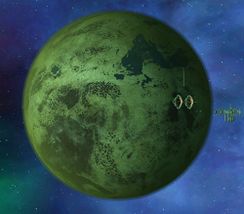
|
This wiki is closed in favour of the new wiki. Information shown is likely to be very out of date. |
Planet Malta
| Planet Malta | |
| Owner | |
| Location | 5D, Omicron Alpha |
| Technical information | |
| Population | 470,000,000 |
| Docking | Yes |
| Terrain | Terrestrial |
| Diameter | 13,534 km |
| Mass | 6.02 x 1024 kg |
| Temperature | -23°C to 31°C |
| Escape velocity | 12.69 km/sec |
The fifth sleeper ship, the Hispania, launched at the same time as its sister ships and broke through the Coalition blockade in the Sol system. Unfortunately, sabotage by Coalition agents that had secreted themselves onboard crippled the engines just as the vessel arrived in the Sirius sector. The passengers awakened from their cryogenic sleep to discover the ship was drifting towards an unknown star system. When the Hispania drifted within range of a red dwarf system, conflict aboard the ship escalated, and about half of the surviving colonists decided to take escape pods, chancing their survival on the promise of a habitable world. The remaining half coaxed the damaged vessel onwards to its eventual destination in the Omicron Alpha system, arriving some time in the year 41 A.S. Upon their arrival, the crew discovered a Planet capable of supporting human life in orbit of the primary star. The Hispania's passengers named the Planet Malta -- a harsh place of acidic oceans, gray skies, and vast plains covered in a species of tall, thin, orange grass. Taking whatever equipment they could salvage from the crippled Hispania, they left the hulk in orbit of Malta and began to make a home for themselves on Malta.
Eventually the Outcasts -- as they came to think of themselves -- began a limited exploration of their home system. As Pilots wandered farther and farther afield in search of resources, many became seriously ill. Upon returning to Malta fall, the crews recovered quickly. After making a number of genetic scans of critically ill Pilots, the doctors made a startling and disturbing discovery. Their genetic code had been altered considerably. The Outcast human DNA was found to contain strands identical to that of the orange grasses that covered the Planet -- from which the drug Cardamine was derived. Trace amounts were present in everything on the planet, in their food, their water, even the very air. Once Pilots made lengthier journeys away from Malta, their bodies went into shock, followed by death.
The Outcasts were now truly separated from the rest of humanity -- changed so that they could never expand beyond the planet on which they had landed. They needed the Cardamine now, like air, food or water. But with the origin of the sickness solved, they could at least compensate by carrying supplies of Cardamine with them and resume their exploration of their surrounding systems. Over time, their knowledge of Cardamine improved, and the Outcasts learned that distributing it in a highly concentrated dose causes extreme euphoria. When they finally encountered the rest of the Houses in the seventh century, a new strategy emerged. The Outcasts would deliver the poison that would rot the other Houses from the inside out and grow rich from the profits of their trade.
Malta's population at the last planetary census in 816 A.S. stood at roughly 470 million, with an estimated 2 million other Outcasts spread across Sirius in various capacities. The Planet's crust is largely devoid of usable metallic elements, with a few notable exceptions, namely at the heart of her largest continent, and highly unusual deposits of metallic Copper on the ocean floor. Most of its land mass is covered in prairies with natural, low-grade Cardamine grass; large plantations with heavily bred and modified strains have been built on the most fertile sites. Malta's architecture is a largely low-hung and flat, one-story affair in the rural areas; cities are an expression of extremes, built almost entirely in the rare hilly regions of the planet. There is little at ground-level, except starports; most structures are built both deep into the ground and into massive towers that reach towards the sky, constructed yet again as to mimic the textures of the ground. Malta's oceans are strongly acidic and home to algae that tolerate it's high acidity. They appear to hold a slightly green tint from the surface.
These days the Outcasts conduct a lucrative drug-smuggling operation using the network of Jump Holes to escape detection and transport their product into the heart of the House systems through various proxies. They remain relatively few in number; a crash in the birth rate seems to have been another side effect of their genetic modification, although the modifications have lengthened the Outcasts lifespan and physical resilience considerably. There have been no known cases of cancer on Malta since the Outcasts made planetfall.
A new development has been Cryer's continued efforts to create a synthetic version of Cardamine that would be approved as a legal medication within Liberty. This poses a direct threat to the Outcasts' source of income. The Atka Research Station, with nearby access to Edge Nebula clouds, is the most immediate threat to the Outcasts. The location of the base within Corsair territory has brought the Outcasts into conflict with their ancient brethren. The Atka Research Station has come under repeated attacks by Outcast raiding parties in recent years, and the Outcasts always destroy any Cryer Transports encountered throughout Sirius without mercy.
Missions Offered
| [show]Spoiler: |
|---|
Bribes Offered
| [show]Spoiler: |
|---|
Commodities
| Exports |
Ships
|
|
